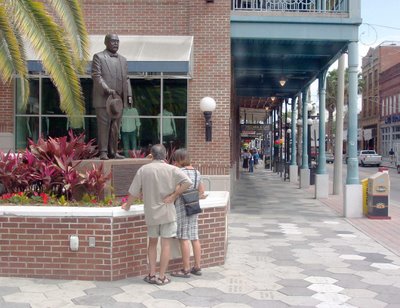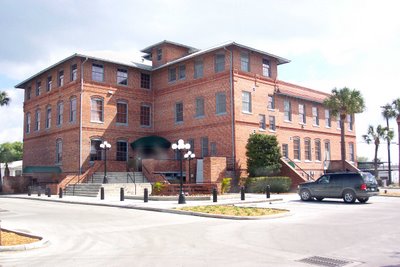
William M. Dowd photos
IN THE RAIN FOREST, St. Croix -- As rain forests go, this isn't much of one.
We're bumping along a rutted one-lane road, or what passes for one on an island with no particularly good roads of any kind and a lot of deserted shells of buildings. Typical of the other face of the Caribbean, the one the tourists aren't meant to see. The rundown homes, peeling paint, piles of rusted-out barrels and other metal debris; the scrawny goats and chickens that meander about, poking into corners for something to eat, and competing for walking space along the roads with uniformed school children looking bright-eyed despite the obvious poverty.
We'd been put on the trail of a particular drink called a "Mama Juana," apparently something very special on this American Virgin Island. Go into the rain forest, we'd been told. Look for The Domino Club. That's where you'll find it. And look for the beer-swilling pigs while you're at it.

The 15-acre western part of the island is dotted with all sorts of trees -- kapok, mahogany, turpentine -- as well as scraggly vines and ferns. The occasional banana quit, hummingbird or yellow warbler darts through the thick vegetation.
This spot north of the capital city of Frederiksted is privately owned, although no one stops the public from wandering through it, especially on a variety of narrow trails that snake through the underbrush.
Just when it seems we might have taken a wrong turn, suddenly we are there.
Our driver pulls off the tight road and our little group scrambles out, anxious for a Mama Juana or two. But first, we have to visit the wild, beer-swilling pigs.
A couple of accuracy alerts. For one, according to the strictest botanical definition, this isn't technically a rain forest, we're told, although no one seems to be able to supply that definition. For another, the pigs we were there to visit actually are boars. And for a third, we are told these particular boars are domesticated and have inherited their jobs from a previous generation of once-wild ones that drank real beer. The current creatures drink only O'Doul's non-alcoholic brew, a nod to animal rights groups.
Jacqueline, a stout, blonde-haired woman of indeterminate age, lines us up in front of the high-walled enclosure where she says the pigs live.
"Here's the drill," she says, mustering up all the charm of a Marine drill instructor. "Three dollars each for admission, a dollar a can for the beer, an extra five dollars if you want to shoot any video. Now, how many of you are coming in?"
We dutifully pay our money, then walk through the doorway, immediately spotting a pair of boars behind cement pen walls. They'd just stepped in from their larger outside pen. They are thirsty and bang against the walls.
"Don't let their tusks scare you," Jacqueline says. "Their teeth don't start till way back in their mouth, so you can place a can of beer in their mouth and they'll bite down on it without hurting you."
Several timid feints and the first of our group successfully "feeds" a beer to a boar. It clamps its powerful jaws on the can, crushing it and releasing the foaming brew. He guzzles the beer, spits out the can and looks around for more. His penmate does the same.
The process goes smoothly through most of two six-packs, until one of our group gets a little sloppy, or one of the boars does. A crushed can explodes its contents onto our companion's shirt front, soaking him to the skin. That's the end of the boar fest, and we head across a small clearing to the Mount Pellier Hut of The Domino Club.
We commandeer a rickety table in the thatched three-room hut. The place is dominated by a long bar in a dark part of the structure peopled by a couple who look as if they've been seated there for a very long time. Jaxcqueline, it turns out, also is the head bartender and in charge of the only other obvious employee.
The Domino Club is a structure that looks as if, in case a shot is fired and the authorities are called, it can be packed away and disappear in seven minutes flat.
We order Mama Juanas, then think to ask what is in the drink. Rum, honey and herbs, we're told. What kind of rum? What kinds of herbs? Just herbs, is the answer. Special herbs. And, don't chug the shots, we are warned.
We hoist, toast and -- despite the instructions -- chug. God almighty. This is vile stuff, is my first thought. I'll never need cough medicine again, is my second. The potion should be called Mama-don't-wanna.
Our driver is getting impatient. We don't mind, clambering back into the van and rattling off into what's left of this not-quite-a-rainforest, curiosity quenched, even if our thirst isn't. But, there is a nice bar back at the hotel that serves any kind of cocktail you can think of.
Aah, civilization.

ON THE WEB•
St. Croix, USVI, Tourism•
Dowd's Guides
 MONTICELLO, NY -- The Sullivan County Legislature today approved an agreement with the Seneca Nation of Indians and Seneca Catskills Gaming Corporation to develop a casino resort on 63 acres of land in the Catskill Mountains.
MONTICELLO, NY -- The Sullivan County Legislature today approved an agreement with the Seneca Nation of Indians and Seneca Catskills Gaming Corporation to develop a casino resort on 63 acres of land in the Catskill Mountains.
















